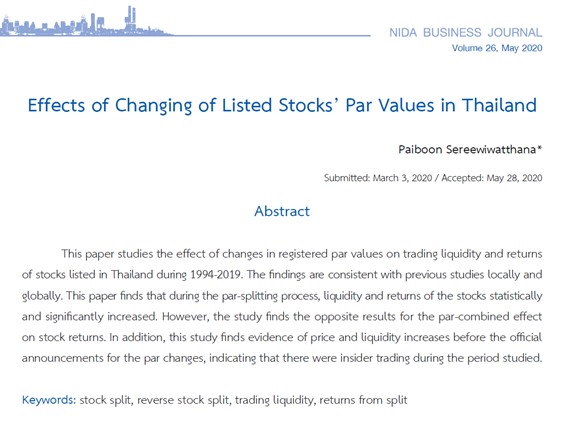Effects of Changing of Listed Stocks’ Par Values in Thailand
Keywords:
stock split, reverse stock split, trading liquidity, returns from splitAbstract
This paper studies the effect of changes in registered par values on trading liquidity and returns of stocks listed in Thailand during 1994-2019. The findings are consistent with previous studies locally and globally. This paper finds that during the par splitting process, liquidity and returns of the stocks increased statistical significantly. However, the study finds the opposite results for the par combined effect on stock returns. In addition, this study finds the evidence of price and liquidity increases before the official announcements for the par changes, indicating that there were insider tradings during the period studied.
References
Angel, J. (1997). Tick size, share prices, and stock splits. Journal of Finance, 52, 655–681.
Arbel, A., & Swanson, G. (1993). The role of information in stock split announcement effects. Quarterly Journal of Business and Economics, 32(2), 14-25.
Asquith, P., Healy, P., and Palepu, K. (1989). Earnings and stock splits. Accounting Review, 64(3), 387-403.
Baker, K., & Gallagher, P. (1980). Management's view of stock splits. Financial Management, 9(2), 73-77.
Baker, K., & Powell, G. (1993). Further evidence on managerial motives for stock splits. Quarterly Journal of Business and Economics, 32(3), 20-31.
Bar-Yosef, S., & Brown, L. (1977). A reexamination of stock splits using moving betas. Journal of Finance, 32(4), 1069-1080.
Brennan, M., & Copeland, T. (1988). Beta changes around stock splits: A note. Journal of Finance, 43(4), 1009-1013.
Byun, J., & Rozeff, M. (2003). Long-run performance after stock splits: 1927 to 1996. Journal of Finance, 58(3), 1063-1085.
Chemmanur, T., Hu, G., and Huang, J. (2015). Institutional investors and the information production theory of stock splits. Journal of Financial and Quantitative Analysis, 50(3), 413-445.
Chung, K., & Yang, S. (2015). Reverse stock splits, institutional holdings, and share value. Financial Management, 44(1), 177-216.
Conroy, R., & Harris, R. (1999). Stock splits and information: The role of share price. Financial Management, 28(3), 28-40.
Conroy, R., Harris, R., & Benet, B. (1990). The effects of stock splits on bid-ask spreads. Journal of Finance, 45(4), 1285-1295.
Copeland, T. (1979). Liquidity changes following stock splits. Journal of Finance, 34(1), 115-141.
Dennis, P., & Strickland, D. (2003). The effect of stock splits on liquidity and excess returns: Evidence from shareholder ownership composition. Journal of Financial Research, 26(3), 355-370.
Desai, A., Nimalendran, M., & Venkataraman, S. (1998). Changes in trading activity following stock splits and their effect on volatility and the adverse information component of the bid–ask spread. Journal of Financial Research, 21(2), 159-183.
Dubofsky, D. (1991). Volatility increases subsequent to NYSE and AMEX stock splits. Journal of Finance, 46(1), 421-431.
Easley, D., O'Hara, M., and Saar, G. (2001). How stock splits affect trading: A microstructure approach. Journal of Financial and Quantitative Analysis, 36(1), 25-51.
Elfakhani, S., & Lung, T. (2003). The effect of split announcements on Canadian stocks. Global Finance Journal, 14, 197–216.
Gorkittisunthorn, M., Jumreornvong, S., and Limpaphayom, P. (2006). Insider ownership, bid–ask spread, and stock splits: Evidence from the Stock Exchange of Thailand. International Review of Financial Analysis, 15, 450–461.
Gray, S., Smith, T., & Whaley, R. (2003). Stock splits: implications for investor trading costs. Journal of Empirical Finance, 10, 271– 303.
Grinblatt, M., Masulis, R., & Titman, S. (1984). The valuation effects of stock splits and stock dividends. Journal of Financial Economics, 13(4), 461-490.
Han, K. (1995). The effects of reverse splits on the liquidity of the stock. Journal of Financial and Quantitative Analysis, 30(1), 159-169.
Ikenberry, D., Rankine, G., & Stice, E. (1996). What do stock splits really signal?. Journal of Financial and Quantitative Analysis, 31(3), 357-375.
Kadiyala, P., & Vetsuypens, M. (2002). Are stock splits credible signals?: Evidence from short-interest data. Financial Management, 31(1), 31-49.
Koski, J. (2007). Does volatility decrease after reverse stock splits?. Journal of Financial Research, 30(2), 217-235.
Kunz, R., & Rosa-Majhensek, S. (2008). Stock splits in Switzerland: To signal or not to signal. Financial Management, 37(2), 193-226.
Lakonishok, J., & Lev, B. (1987). Stock splits and stock dividends: Why, Who, and When?. Journal of Finance, 42(4), 913-932.
Mcnichols, M., & Dravid, A. (1990). Stock dividends, stock splits, and signaling. Journal of Finance, 45(3), Papers and Proceedings, Forty-ninth Annual Meeting, American Finance Association, Atlanta, Georgia, December 28-30, 1989, 857-879.
Millar, J., & Fielitz, B. (1973). Stock-split and stock-dividend decisions. Financial Management, 2(4), 35-45.
Millar, J. (1977). Split or dividend: Do the words really matter?. Accounting Review, 52(1), 52-55.
Minnick, K., & Raman, K. (2014). Why are stock splits declining?. Financial Management, 43(1), 29-60.
Naratip Tutiag (2017), A Survey of Stock Splits and Reverse Stock Splits of Listed Companies in Thaland. Nida Business Journal, 21, 67-89.
Nayak, S., & Prabhala, N. (2001). Disentangling the dividend information in splits: A decomposition using conditional event-study methods. Review of Financial Studies, 14(4), 1083-1116.
Ohlson, J., & Penman, S. (1985). Volatility increases subsequent to stock splits: An empirical aberration. Journal of Financial Economics, 14(2), 251-266.
Pavabutr, P., & Sirodom, K. (2010). Stock splits in a retail dominant order driven market. Pacific-Basin Finance Journal, 18(5), 427-441.
Schultz, P. (2000). Stock splits, tick size, and sponsorship. Journal of Finance, 55(1), 429-450.
Wiggins, J. (1992). Beta changes around stock splits revisited. Journal of Financial and Quantitative Analysis, 27(4), 631-640.

Downloads
Published
How to Cite
Issue
Section
License
Copyright (c) 2020 https://creativecommons.org/licenses/by-nc-nd/4.0/

This work is licensed under a Creative Commons Attribution-NonCommercial-NoDerivatives 4.0 International License.



